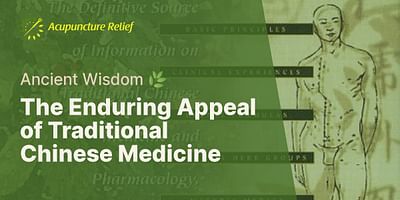James Sullivan is a health and wellness writer with a keen interest in alternative medicine. He discovered acupuncture as a means to manage chronic pain and has since dedicated his writing career to sharing his experiences and knowledge. James holds a degree in Journalism from the University of California.
Chinese medicine is a holistic approach to healthcare that has been practiced for thousands of years. It is based on the belief that the body is a complex system of interconnected parts, and when these parts are in balance, we experience good health. When there is an imbalance, however, it can lead to illness or discomfort.
At the core of Chinese medicine is the concept of Qi (pronounced "chee"), which can be loosely translated as vital energy or life force. According to Chinese medicine, Qi flows through the body along pathways called meridians. When Qi is flowing smoothly, we feel healthy and vibrant. But if there is a blockage or imbalance in the flow of Qi, it can lead to pain, illness, or other health issues.
Chinese medicine uses various techniques to restore the balance of Qi in the body. One of the most well-known and widely practiced techniques is acupuncture. Acupuncture involves the insertion of thin needles into specific points along the meridians to stimulate the flow of Qi and restore balance. This can help alleviate pain, reduce inflammation, and promote overall well-being.
Another technique used in Chinese medicine is herbal medicine. Chinese herbs are carefully selected and combined to create formulas that target specific imbalances in the body. These formulas can be taken as teas, powders, or pills to support the body's natural healing processes.
In addition to acupuncture and herbal medicine, Chinese medicine also incorporates other modalities such as cupping, moxibustion, and Tui Na massage. Cupping involves placing glass or plastic cups on the skin to create suction, which helps to improve circulation and relieve muscle tension. Moxibustion involves burning a dried herb called mugwort near the skin to warm and stimulate specific acupuncture points. Tui Na massage is a form of therapeutic massage that uses rhythmic compression and stretching techniques to promote the flow of Qi and relieve muscle tension.
Chinese medicine takes a holistic approach to health, considering not only the physical body but also the mind and spirit. It emphasizes the importance of maintaining a healthy lifestyle, including proper nutrition, exercise, and stress management. By addressing the root causes of illness and promoting overall balance, Chinese medicine aims to support the body's innate healing abilities.
It's important to note that Chinese medicine is a complementary therapy and should not replace conventional medical treatment. If you have a serious medical condition, it's always best to consult with a qualified healthcare professional.
In summary, Chinese medicine works by restoring the balance of Qi in the body through techniques such as acupuncture, herbal medicine, cupping, moxibustion, and Tui Na massage. By promoting the flow of Qi and addressing the root causes of illness, Chinese medicine aims to support the body's natural healing processes and promote overall well-being.















